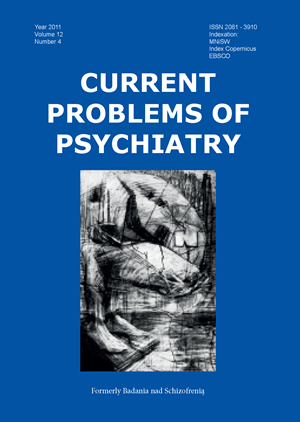Assessment of premorbid adjustment in patients with paranoid schizophrenia
Keywords:
premorbid adjustment, paranoid schizophreniaAbstract
Aim. The aim of the study was to assess premorbid adjustment in patients with paranoid schizophrenia in the context of the psychopathological picture.
Method. The subjects were the patients with paranoid schizophrenia hospitalized in the Psychiatry Department of Medical University of Lublin between 2010-2011. Sociodemographic Inventory, which comprises the following information: age, level of education and job status and the course of the illness, was used. The following instruments: Brief Psychotic Rating Scale, Premorbid Adjustment Scale and the Content of Delusions Inventory were also applied. The results were analyzed with the Spearman’s rank correlation coefficient.
Results. Positive correlations among all the subscales of Premorbid Adjustment Scale were found. Men showed worse premorbid adjustment than women. The symptom – flattened affect – was related to poorer adjustment in childhood and in the early adolescence. It was found that most psychopathological symptoms were related to worse adjustment in adolescence, although there were visible differences in the correlations with particular symptoms assessed with BPRS and delusions assessed with the Content of Delusions Inventory and Dimensions of Delusions Inventory.
References
1. Eckholdt H.M., Lenzenweger M.L. Premorbid adult social competence, socioeconomic status and psychopathology . J Nerv Ment Dis, 1990; 178:139-140.
2. Grzywa A. , Śpila B., Karakuła H., Hennel A., Wieczorek J., Kozak G., Jędrych M. Przystosowanie przedchorobowe w schizofrenii paranoidalnej. Bad. Nad Schizofrenią,1993;111-116.
3. Grzywa A. Geneza, struktura i dynamika urojeń w schizofrenicznych zespołach paranoidalnych . Rozprawa habilitacyjna. Lublin; Akademia Medyczna w Lublinie: 1991.
4. Birchwood M., Jackson Ch. Schizofrenia. Modele i techniki terapeutyczne. Gdańsk; GWP: 2004.
5. Romm K.L., Rossberg J.I., Hansen Ch.F., Haug E., Andreassen O.A., Melle I.M. Self-esteem is associated with premorbid adjustment and positive psychotic symptoms in early psychosis. BMC Psychiatry, 2011; 11:136.


